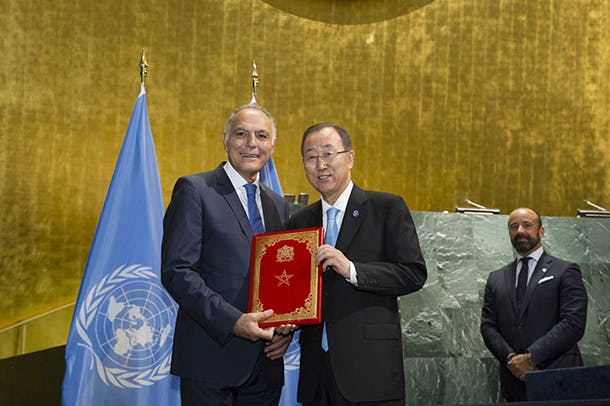
Last week at the United Nations, Secretary-General Ban Ki-moon convened a special event for nations to formally join the Paris Agreement on climate change, the first international accord to unite all nations to take bold action to address climate change.
This is the end point of a three-stage process: The agreement was reached in Paris last December and signed at the UN on Earth Day. Now, to enter into legal force, it must be formally joined by at least 55 countries representing at least 55% of the world’s emissions.
Even ahead of this special climate event at the UN on September 21, the Paris Agreement was moving forward with unprecedented speed and support. It had been signed by 191 countries and formally joined by 29 countries representing 39% of the world’s emissions. Among them were the world’s two largest emitters, the United States and China, which together represent 38% of the world’s emissions and which formalized their approval at a joint ceremony on September 3.
Still, there was more work to be done as leaders met in the General Assembly Hall last week. During the hour-long event, 31 countries formally joined the agreement, bringing the total number of countries to join the agreement to 60. Through new commitments from countries including Mexico, the United Arab Emirates, and Brazil, the Paris Agreement sailed past one of the two thresholds needed for entry into force.
Now 61 countries have joined the climate accord, representing 48% of the world’s emissions. That means it needs an additional 7% of the world’s emissions to enter into legal force. A big breakthrough came on Sunday, when Indian Prime Minister Narendra Modi announced that his country, the world’s third largest emitter, will join the Paris Agreement on October 2 – the birthday of Mahatma Gandhi, the founding father of modern India. India accounts for 4.5% of the world’s emissions, and its participation will bring the Paris Agreement within 2.5% of entry into force. The prospects are very bright for clearing that final hurdle later this year, perhaps by the next major climate conference in Morocco in November.
Also important for the future of the climate is a meeting coming up in Rwanda in just a few weeks, where signatories to the Montreal Protocol (the international treaty designed to protect the ozone layer) will consider an amendment that would eventually eliminate the use of hydrofluorocarbons, or HFCs. HFCs are currently used in air conditioners and refrigeration systems around the world, but pound for pound, these chemicals are far more powerful greenhouse gases than carbon dioxide.
This potential amendment to the Montreal Protocol, while it hasn’t garnered the public attention that it deserves, has been called “the climate’s low-hanging fruit” by UN climate chief Patricia Espinosa, who says it could prevent the equivalent of 100-200 billion tons of carbon dioxide emissions by 2050. That reduction alone, she adds, could bring the world a quarter of the way to meeting the target of limiting the increase in global temperatures to 2 degrees Celsius.
These encouraging events remind us of the power of international institutions like the UN to unite nations, businesses, and citizens around a common goal – in this case, the future of people and our planet.
Addressing climate change will be a marathon, not a sprint. While we’ve seen great progress in the last nine months, we still have much more to do. Continued public support for climate action will be ever more important in the months and years to come.
[Photo: UN Photo/Rick Bajornas]



 View All Blog Posts
View All Blog Posts